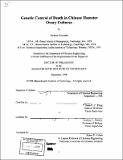| dc.contributor.advisor | Daniel I.C. Wang and Anthony J. Sinskey. | en_US |
| dc.contributor.author | Goswami, Joydeep, 1971- | en_US |
| dc.date.accessioned | 2010-01-07T20:47:46Z | |
| dc.date.available | 2010-01-07T20:47:46Z | |
| dc.date.copyright | 1998 | en_US |
| dc.date.issued | 1998 | en_US |
| dc.identifier.uri | http://hdl.handle.net/1721.1/50513 | |
| dc.description | Thesis (Ph.D.)--Massachusetts Institute of Technology, Dept. of Chemical Engineering, 1998. | en_US |
| dc.description | Includes bibliographical references (p. 195-209). | en_US |
| dc.description.abstract | One of the main problems in mammalian cell culture systems, including Chinese Hamster Ovary (CHO) cultures, is the inability to maintain viability of these cultures over extended periods of time. This inability translates into lower final protein titers and higher protein production and recovery costs. This thesis was undertaken to better understand the processes of death in CHO cells and to find ways to extend the viability of CHO cultures. A majority of CHO cells in culture were found to die by apoptosis, a genetically controlled form of cellular suicide. Protein synthesis inhibition in CHO cells led to rapid death, indicating that CHO cells were pre-disposed to death and that survival proteins needed to be continuously synthesized to protect cells from death. Caspases, a class of proteins found to be universally important in inducing apoptosis, were found to be activated in apoptotic CHO cells. Surprisingly, inhibition of caspase activity using z-VAD.fmk, a universal peptide inhibitor of caspases, failed to significantly extend viability in batch culture although it did prevent cleavage of known intracellular caspase substrates. In contrast, expression of bcl- 2, a well-characterized anti-apoptotic gene, was able to significantly increase the life of CHO batch cultures in response to both glucose limitation and growth factor withdrawal. Using these results, a pathway for apoptosis in CHO cells, focusing on the caspases and bcl-2, was suggested. An experiment was devised to statistically measure the ability of individual cells to replicate. Replication competence was found to correlate well with viability results from the acridine orange / ethidium bromide assay, but not with results from the trypan blue assay. These experiments proved that early apoptotic cells, which have lost membrane integrity but not chromatin integrity, can be considered dead since they lose the ability to replicate. In addition, the experiments proved that bcl-2 expression is able to extend the replication competence of cells under normal culture conditions. Bcl-2 expression was shown to improve both final product titers and integrated viable cell densities in CHO fed-batch cultures. It was also able to maintain insulin deprived fed-batch cultures in a viable and productive state for much longer than insulin supplemented cultures, thus suggesting an easy way to maintain viability and productivity coupled with slower growth. A slower growth rate has been reported in literature to yield higher product quality and productivity. Concentrations of insulin, a growth and survival factor used in CHO culture, were observed to drop rapidly in fed-batch cultures of CHO cells. The loss of insulin was concurrent with the accumulation of cells in the GO/G1 state and an increase in expression levels ofp53, a well-documented growth-inhibiting and apoptosis-inducing gene. Insulin degrading activity was found to be at least partially caused by release of proteases from cells into the culture medium. Insulin degradation was sharply reduced by adding sodium glycocholate, an amino-peptidase inhibitor, suggesting that amino-peptidases play a major role in insulin degradation in CHO fed-batch cultures. Based on the above results, possible ways to further reduce death and improve productivity in CHO cultures are also suggested. | en_US |
| dc.description.statementofresponsibility | by Joydeep Goswami. | en_US |
| dc.format.extent | 210 p. | en_US |
| dc.language.iso | eng | en_US |
| dc.publisher | Massachusetts Institute of Technology | en_US |
| dc.rights | M.I.T. theses are protected by
copyright. They may be viewed from this source for any purpose, but
reproduction or distribution in any format is prohibited without written
permission. See provided URL for inquiries about permission. | en_US |
| dc.rights.uri | http://dspace.mit.edu/handle/1721.1/7582 | en_US |
| dc.subject | Chemical Engineering | en_US |
| dc.title | Genetic control of death in Chinese Hamster Ovary cultures | en_US |
| dc.title.alternative | Genetic control of death in CHO cultures | en_US |
| dc.type | Thesis | en_US |
| dc.description.degree | Ph.D. | en_US |
| dc.contributor.department | Massachusetts Institute of Technology. Department of Chemical Engineering | en_US |
| dc.identifier.oclc | 42415529 | en_US |
